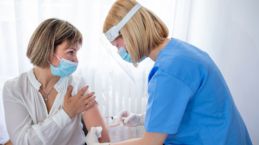

insights
The Role of Clinical Research: Develop Patient Trust through Vetted, Trusted Science
The American public often consumes news quickly through online sources, and the feeds of social media allow anyone to stay ‘on the pulse.’ Even Twitter and LinkedIn are primary sources for scientific updates. Most of us know this routine all too well: scroll through your daily news digest email and read through your LinkedIn and Twitter headlines before you get ready for the responsibilities of your day. But how much of what we’re reading, particularly as it relates to scientific information, is truly accurate? What does it really mean to ‘believe in science” or develop patient trust”? How are we able to decipher between science and propaganda?
As we’ve seen over the years, the trustworthiness of science is often debated in public – and through social media platforms – and the narrative that science is not trustworthy has been repeated and often fueled by a lack of belief. From the validity of climate change to the safety of COVID-19 vaccines, ‘science’ has become a political catchword. Even a few days before President Joe Biden was elected president, he mentioned “I believe in science.”
Belief in science has ever reaching value. That belief can incite a willingness to adhere to global health crisis recommendations, participate in clinical trial research projects that benefit communities, and make decisions that benefit communities and future generations.
In this article, we will explore ways social media continues to enable scientific mistrust, how to debunk propaganda even for non-scientists, and how we can all benefit from more grounded scientific knowledge that benefits our communities.
How Social Media Enables Scientific Mistrust
During COVID-19, the general public often used social media as a primary source of information. Users saw a rapid spread of scientific information and misinformation being shared on a daily, if not hourly, basis. Within just the first 12 days of April 2020, there were about 25 Facebook posts per day regarding COVID-19-related conspiracy theories or myths. On average, about three of those conspiracy theories called for some form of action against the government for their measures taken for COVID-19. 1
With continuous misinformation, public health officials and the science communities are probing the questions “why is there general mistrust?” and “how do we build trust?” Little research has been conducted investigating the relationship between social media usage and mistrust in science, but we have found some emergent articles that review the correlation between social media and the spread of misinformation. Several theories for this could be from historical wrongdoings of the scientific community towards marginalized groups, general suspicions around scientists, continuous scientific discovery and progress that may lend previous facts invalid, or the rapid spread of information (opinion or fact) via social media platforms.
Social media can further accelerate mistrust in science due to the nature of the platform – anyone can pose as an “expert” and a significant portion of the public uses social media (according to Pew Research, in February 2021, 72% of U.S. adults have stated that they use at least one social media site and usage seems to increase year by year.)2 We have seen a rapid spread of media containing false information that creates states of ideological frame (i.e., filter bubbles). These states of ideological frame limit the amount of information a person sees when using social media and is further enhanced the more someone interacts with social media due to their algorithm that becomes more skewed and biased based on their interactions on various platforms.
Here are three ways to spot misinformation on social media:
- Generalization of groups of people or the effects of a specific disease or medicine
- Significantly detailed information but no references to a reputable resource
- Strong opposition to what is considered safe or correct by large scientific organizations like the U.S. Federal Food and Drug Administration (FDA) or the Centers for Disease Control and Prevention (CDC) with no references to back up the claim
Foundational Players Behind Debunking Scientific Propaganda
The process of ‘debunking’ scientific propaganda is multilayered with attempts to attack the proliferation of misinformation both online and in person. The three-tiered approach as described by the Co-Founder of FactCheck.org, Kathleen Hall Jamieson, layers big corporations, individual scientific experts, and primary connections as foundational players to bolster science and weed out propaganda.
Here is her assessment of the context behind scientific propaganda:
- Willingness of a platform (YouTube, Facebook, Twitter, Reddit, etc.) to block the rapid spread of misinformation at the source
- There is not always a rapid willingness
- Societal pressure on corporations supporting big tech companies helped strongarm tech giants to crack down on COVID-19-related misleading information and conspiracy theories
- Fact-checking organizations leverage appropriate health sources that are able to refute false or misleading health information found on social media
- Corrections to information need to be done clearly, simply, and with evidence that non-experts can digest
- A primary connection, like a neighbor or a friend, can respond with messages tailored to a person’s interests and concerns
- If both parties feel engaged in a dialogue, the conversation can have a very positive correction to misconceptions in real-time and set the tone for an environment inhospitable to misinformation going forward
- Teach that science is dynamic and self-correcting. In grade school, students are taught how to conduct experiments to reach plausible answers to questions. Over time, the more we research and uncover information, we are able to take that insight and adjust previously held beliefs
An interesting but illustrative point of information silos that Ms. Jamieson notes is that “Deception and debunking usually occur in different venues: those who are exposed to misconceptions rarely encounter the fact-checks.”3
The Escalating Impact of Scientific Propaganda and The Role of Clinical Research
When we examine the effects of scientific propaganda and misinformation, we often review the impact on a particular person. For example, we may see the thoughts and opinions of one individual and consider them uninformed, but what happens when this information spreads and starts to impact entire communities?
Over time, we have seen a “disconnect between public opinion and scientific consensus”4 on many different hot-button topics. These topics include vaccine safety for children, thoughts on evolution and climate change, and most recently, COVID-19 vaccines as the best method of intervention.
An article by Scheufele and Krause highlighted two very important points regarding why misinformation in certain communities can be spread so quickly. The first point addresses the psychology behind boisterous individuals about their belief systems. The article states that people can be broken into three groups:
- Informed but inactive
- Uninformed
- Misinformed but active
These groups of misinformed, active people are less likely “to abandon old beliefs, accept new ones, abandon old allegiances, find a new group, and change their behavior,”4 which means when they are presented with accurate and vetted information, they will continue to spread the information they believe is true. This can be particularly dangerous for communities that are underrepresented, rural, have less access to information, or are socioeconomically stunted. Additionally, there is an overwhelming amount of trust within the communities from pastors, parents, teachers, and even service providers (like barbers and nail technicians) that seem to offer a source of truth.
“Specifically, individuals are more likely to accept information that appears to follow a logical narrative, that comes from a source they perceive to be “credible,” that is consistent with their preexisting values and beliefs, and that seems to be something other people believe.”5
The increasing negative information and misinformation could increase unhealthy lifestyles, affect the community over time, and may eventually affect outside communities. More specifically, we have seen the influence of misinformation as it relates to COVID-19 therapeutics. We saw conflicting information about the safety and efficacy of the vaccines, what consisted of the vaccines, how quickly they came to market, and their overall effects. This misinformation caused some who were ill-informed to self-medicate using at-home remedies and concoctions that were potentially dangerous. This was especially prevalent during the COVID-19 pandemic. “During COVID-19, the major factors associated with self-medication were fear, anxiety, and perception regarding COVID-19. Thus, in this pandemic, fear, anxiety, and rumors regarding immunity boosters, nutritional supplements, financial burden, and easy accessibility to even non-OTC drugs; all have their fair share in self-medication practices.”6
As people who are engaged in scientific research, we have to continue to find ways to gain trust within the communities we are a part of and spread factual, unbiased, and well-vetted information.
Conclusion
In conversations (virtual or in-person) where misconceptions or erroneous information is prevalent, there is not always someone there to provide a counterpoint or inquire whether the source has researched the information they are disseminating. It’s essential to develop trusting relationships and hold discussions that center around well-researched, scientifically accepted information because that’s for the betterment of communities.
We have looked at the reasons why scientific propaganda can be dangerous, why it can be spread, and the difference between science and propaganda. So, what is the solution? There is not one single solution. It takes different groups of professionals to continue to present safe and engaging spaces to disseminate scientifically sound information.
Clinical trial sponsors are often at the forefront of groundbreaking research, and for the research to progress, patient engagement is essential. Sponsors must focus on improving their communication with the patients fit for their study, and this could mean holding a greater presence on social media and forums where potential patients may ask questions. Additionally, engaging with advisory groups that are well-versed in patient engagement strategies may provide resources that help foster communication, understanding, and support for science.
Halloran offers patient-centric clinical trial design consulting. Please contact a member of our team today to start the discussion.
References:
- Constantinou M, Kagialis A, Karekla M. COVID-19 Scientific Facts vs. Conspiracy Theories: Is Science Failing to Pass Its Message? Int J Environ Res Public Health. 2021 Jun 11;18(12):6343.
- https://www.pewresearch.org/internet/fact-sheet/social-media/
- https://www.scientificamerican.com/article/how-to-debunk-misinformation-about-covid-vaccines-and-masks/
- Scheufele DA, Krause NM. Science audiences, misinformation, and fake news. Proc Natl Acad Sci U S A. 2019;116(16):7662-7669.
- JL Hochschild, KL Einstein, Do facts matter? Information and misinformation in American politics. Polit Sci Q 130, 585–624 (2015).
- Shrestha AB, Aryal M, Magar JR, Shrestha S, Hossainy L, Rimti FH. The scenario of self-medication practices during the covid-19 pandemic; a systematic review. Ann Med Surg (Lond). 2022 Oct;82:104482.




